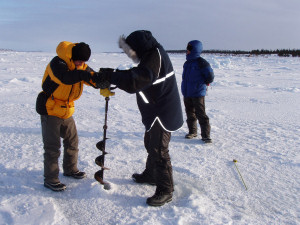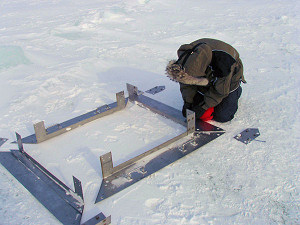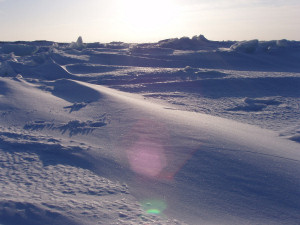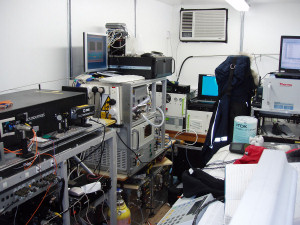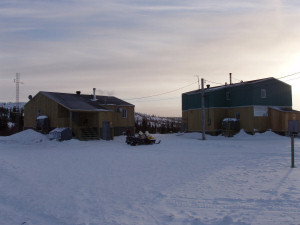COBRA Photo Album
Please click on the images below to view the full series of images for that topic. Additional images and commentary from the COBRA project may be found on the blog kept by Roisin Commane a PhD student from the University of Leeds located at http://arcticroisin.blogspot.com/.
Creating an artificial lead
The process of creating an artificial lead ie a 1m square hole through ice which was up to 1.2m thick was an interesting and unexpected one. We had expected that these holes would be cut for us, but in the end it didn’t quite work out that way. The process consisted of the following steps: drill a series of holes with a big petrol driven drill, cut through the ice between the holes with a saw, making two cuts between each hole, and remove the chunk of ice between so the cut does not re-freeze. When the block of ice in the middle is completely free, sink it, and push it away under the ice. Then trim the hole as required with the saw and an axe. Sounds simple doesn’t it?
Then once you have made a hole what do you do next? At these temperatures, it’s not long before it starts to freeze, in fact ice builds up at a rate of up to 4 inches per day. So you have to smash it out again with a hammer or an axe… just remember not to let go of the hammer!
Working on the ice
Set up and maintenance of the ice camp and artificial leads involved spending considerable time out on the ice, with essentially whole days being spent there, with only a break for lunch back at the research station. With temperatures ranging between -15 and -39 deg C, even simple tasks took much longer than expected, doing intricate work is almost impossible, and things which are normally flexible go brittle and crack. The nature of the experience of being out on the ice was very much dependant on the weather, if the wind was low, and the sun was up, then conditions were relatively pleasant, but you soon are reminded how cold it really is if ears or fingers are left exposed for too long. However conditions are much more severe when there are strong winds and blowing snow. Working on the ice also called for considerable physical exertion, especially in creating and maintaining the leads, but also in moving equipment out on to the ice, especially if pulling the sled by hand. Even at such low temperatures, it was easy to get overly warm, but of course anything which gets wet whether through exertion, or through splashing of sea water from clearing the leads, is then liable to freeze…
Ice landscapes
Sea ice is rather different than a frozen lake, it is not a vast expanse of smooth level ice. Sea ice is shaped by tidal forces being pushed up into ridges with level areas in between. The ridges are made up of broken slabs pushed up at all sorts of angles, which are then sculpted by the sun, wind and snow to create a very unusual and beautiful landscape. Taking a walk a relatively small distance beyond our ice camp gave a definite feeling of having entered another world, of being a guest of the polar bear. Sea ice is continuously on the move, and continuously changing, while our site being close to the shore did not move significantly during the duration of the experiment, there was evidence of the ice being pushed up the shore, with cracks increasing in size and new ones opening up. Standing still on the ice it was often possible to hear the creaking and cracking beneath your feet.
Instruments
Many instruments were deployed to make the suite of measurements required to meet the COBRA objectives. As well as being located out on the ice, many of these were located in the containers on the shore. The majority of in-situe instrumentation was located in the York container, and as can be seen from the photographs, it got pretty crowded. Temperature was also a problem, this time heat rather than cold, with so many instruments crammed into an insulated box, especially at night when no one was in the container and the door was shut. Next door in the DOAS container there was plenty of space, and the temperature was just about right, but going in and out too much upsets the instruments.
Around Town
Most accomodation was provided on the first floor of the research station building, in fairly small rooms with bunk beds. On the ground floor of that building there were labs where some of the instrumentation for the COBRA project, and various other kit was located. The building next door is the dining room where we enjoyed the excellent food prepared by the project cook Jeanette. Beyond the research station was the Inuit town of Kuujjuarapik and the Cree town Whapmagoostui, though I am not sure if any of us knew where the boundary lay. Transport was by truck (often riding in the open back), skidoo, or foot, though that was not the general way to get to the measurement site.
